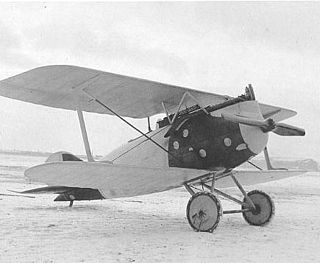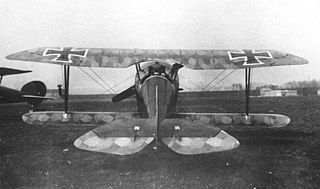
The Albatros W.4 was a German floatplane derivative of the Albatros D.I fighter with new wing and tail surfaces of greater span than the D.I. One hundred eighteen examples were built between June 1916 and December 1917. The aircraft operated in the North Sea and Baltic theatres and later served as training aircraft.

The Hansa-Brandenburg W.12 was a German biplane fighter floatplane of World War I. It was a development of Ernst Heinkel's previous KDW, adding a rear cockpit for an observer/gunner, and had an unusual inverted tailfin/rudder in order to give an uninterrupted field of fire.
The Friedrichshafen FF.43 was a German single-seat floatplane fighter of the 1910s produced by Flugzeugbau Friedrichshafen.

The Daimler D.I was a German fighter aircraft of World War I. It was a conventional biplane design with a very small interplane gap - the top wing nearly touched the top of the fuselage. Power was provided by a Daimler D.IIIb water-cooled V-8 engine.

The Hansa-Brandenburg W.19 was a German fighter-reconnaissance aircraft of World War I. It was a single-engined two-seat biplane floatplane, and was a larger development of the successful W.12. It served with the Kaiserliche Marine during 1918.

The Hansa-Brandenburg CC was a single-seat German fighter flying boat of World War I. It was used by both the Kaiserliche Marine and the Austro-Hungarian Navy.

The Hansa Brandenburg W.27 and W.32 were prototype fighter floatplanes developed in parallel in Germany during World War I. They were developments of and intended replacements for the W.12 then in service and differed from each other principally in the choice of powerplant, the W.27 with a Benz Bz.IIIb and the W.32 with the same Mercedes D.III that the original W.12 used.

The Junkers D.I was a monoplane fighter aircraft produced in Germany late in World War I, significant for becoming the first all-metal fighter to enter service. The prototype, a private venture by Junkers named the J 7, first flew on 17 September 1917, going through nearly a half-dozen detail changes in its design during its tests. When it was demonstrated to the Idflieg early the following year it proved impressive enough to result in an order for three additional aircraft for trials. The changes made by Junkers were significant enough for the firm to rename the next example the J 9, which was supplied to the Idflieg instead of the three J 7s ordered.

The LFG Roland D.I was a fighter aircraft produced in Germany during World War I. It was a single-seat aircraft based originally on the Roland C.II two-seat reconnaissance type. It shared its predecessor's unusual design feature of having a deep fuselage that completely filled the interplane gap, but in comparison, the fuselage was much sleeker. While the C.II's appearance had earned the Walfisch ("Whale"), the D.I became known as the Haifisch ("Shark"). The I-struts that had been used to brace the C.II's wing were replaced by more conventional struts. Other changes to the wing included the removal of stagger from the design and the introduction of slight sweepback.

The Rumpler B.I was a military reconnaissance aircraft produced in Germany during World War I.

The Rumpler D.I was a fighter-reconnaissance aircraft produced in Germany at the end of World War I. It was a conventional single-bay biplane with wings of unequal span braced by I-struts. It featured an open cockpit and a fixed, tailskid undercarriage. The upper wing was fitted with aerodynamically balanced ailerons and fuselage had an oval cross-section.
The Sablatnig SF-5 was a reconnaissance seaplane produced in Germany during the First World War.

The Daimler L11 was a German single-seat, parasol-wing, monoplane fighter built during the First World War for the Imperial German Air Service. A single prototype was built in 1918, but the war ended before it could be accepted for service. The two-seat Daimler L14 was based on this aircraft.

The Zeppelin-Lindau CS.I was a German single-engined reconnaissance seaplane with a low-wing monoplane layout.

The Kondor D 1, given the unofficial name Kondorlaus, was a German single seat, biplane fighter aircraft designed and built close to the end of WWI.

The Kondor D 2 was a German single seat, biplane fighter aircraft designed and built close to the end of World War I.

The Friedrichshafen D.I was a German single-seat fighter plane developed by the Flugzeugbau Friedrichshafen during the First World War. Two prototypes were flown in 1917, but it was judged inferior to the Albatros D.III then in production and no further production ensued.
The Daimler CL.I was a prototype two-seat fighter built in Germany during World War I.
The Hansa-Brandenburg W.25 was a German floatplane fighter of the World War I era, designed and built by Hansa-Brandenburg.

The LTG FD 1 was a single-seat floatplane fighter built for the Imperial German Navy's Naval Air Service by Luft Torpedo Gesellschaft (LTG) during World War I. Only six prototypes were built in 1917–1918 and are not known to have served on active duty.

















